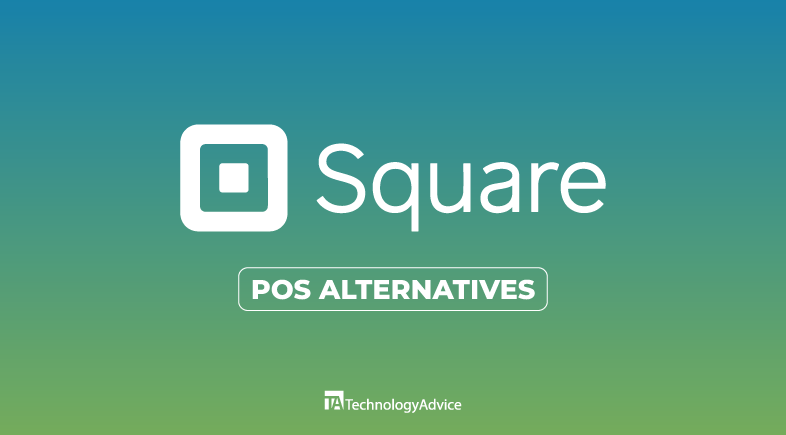A nonprofit organizational chart is paramount to achieving missions effectively. It clarifies roles, responsibilities, and reporting lines to ensure smooth operations. A clear structure fosters accountability, enhancing transparency for donors, beneficiaries, and stakeholders.
It streamlines decision-making processes, promoting efficiency in resource allocation and program execution. Moreover, a well-defined structure facilitates collaboration among team members and volunteers and empowers them by emphasizing their importance in maximizing collective impact.
This empowerment fosters a sense of connection and motivation, making them feel more connected and motivated. By establishing hierarchies, workflows, and communication channels, nonprofits can navigate challenges, adapt to change, and sustain long-term growth while staying true to the nonprofit’s philanthropic goals.
This alignment with their mission fosters a cohesive team environment, facilitating collaboration among staff, volunteers, and stakeholders. By aligning structure with strategic objectives, nonprofits can maximize their effectiveness in delivering programs and services, ensuring they remain focused on their mission while adapting to the evolving needs of their communities.
Also read: Not-for-profit vs. Nonprofit: What’s the Difference?
Understanding your nonprofit organizational structure
A nonprofit organization structure is the framework that defines how a nonprofit operates, manages resources, and fulfills its mission. At its core, the Board of Directors is responsible for governance and strategic direction. Executive leadership, including the Executive Director, oversees daily operations.
Functional departments, like finance, programs, and communications, manage specific aspects of organizational functions. Staff and volunteers implement programs and support functions. Committees or task forces may address specialized areas or initiatives. This structured arrangement ensures clarity in roles, accountability, and efficient coordination of efforts toward achieving the nonprofit’s objectives while adhering to its mission and values.
Expert Tip
Building or refining a nonprofit’s organizational structure should aim to optimize its capacity for impact and sustainability. It establishes clear roles, responsibilities, and reporting lines to enhance operational efficiency and accountability. A well-designed structure enables effective resource coordination, streamlines decision-making processes, and instills a sense of purpose in the nonprofit.
Nonprofit and for-profit organizational structures differ primarily in their missions, sources of revenue, and distribution of profits. Nonprofits aim to address social or community needs, reinvesting surplus funds into their mission rather than distributing profits to owners or shareholders. They rely on donations, grants, and earned income to sustain operations.
Conversely, for-profit organizations prioritize generating profits for owners or shareholders. Their revenue comes from selling goods or services in the market. Governance also varies, with nonprofits overseen by a board of directors focused on mission fulfillment, while for-profits are typically governed by shareholders or owners seeking financial returns.
Types of nonprofit organizational charts
The type of nonprofit organizational chart you use depends on your team’s roles, responsibilities, and reporting relationships. It also depends on your organization’s size, mission, and governance structure. Below are the most common types of nonprofit org charts. You can use them as templates and fill the boxes with the appropriate nonprofit organization position titles.
Laying the foundation: Governance and leadership
In a nonprofit organizational structure, the board of directors plays a crucial role in governance and strategic oversight. They are responsible for setting the organization’s mission, vision, and strategic direction, ensuring compliance with legal and ethical standards, overseeing financial management, and appointing and evaluating executive leadership.
The board also serves as ambassadors, representing the organization to stakeholders and the public, and may engage in fundraising activities. Ultimately, the board of directors is entrusted with safeguarding the organization’s mission and ensuring its long-term sustainability and impact in serving its beneficiaries.
Nonprofits typically select executive leadership through a rigorous process that involves defining the organization’s needs, conducting a comprehensive search, and assessing candidates based on their alignment with the mission, leadership skills, experience, and cultural fit. This process often includes input from the board of directors, staff, and key stakeholders.
Candidates are evaluated on their track record of success, ability to inspire and lead teams, understanding of nonprofit governance and operations, and commitment to the organization’s values. The chosen executive should demonstrate a strong vision for advancing the nonprofit’s mission and driving positive impact.
Moreover, clear roles and responsibilities promote transparency, which is essential for maintaining trust with stakeholders and donors. Finally, establishing clarity in roles and responsibilities lays a solid foundation for effective governance, leadership, and mission fulfillment within the nonprofit sector.
Expert Tip
Ensure roles and responsibilities are clearly defined within a nonprofit’s governance and leadership structure. This clarity fosters efficiency and accountability, minimizes confusion over decision-making processes, and enhances collaboration among board members and staff.
Designing your nonprofit organizational chart
Some of the most common key positions and departments in nonprofits include executive directors and operations administrators.
- Executive director or CEO: This role provides overall leadership, strategic direction, and management for the organization.
- Development or fundraising: This department raises funds through donations, grants, and events.
- Program management: This department oversees the planning, implementation, and evaluation of the programs and services.
- Finance or accounting: This department manages budgeting, financial reporting, and regulatory compliance.
- Marketing or communications: This team handles branding, messaging, public relations, and outreach efforts.
- HR: This team manages recruitment, training, employee relations, and compliance with labor laws.
- Operations or administration: This team supports day-to-day operations, facilities management, and administrative tasks.
Your nonprofit’s roles and departments ensure it functions effectively and fulfills its mission. But to ensure flexibility in an organizational chart that accommodates growth and change, you must:
- Design roles with overlapping responsibilities to adapt to shifting priorities.
- Consider implementing a flat hierarchy or matrix structure to promote collaboration and agility.
- Aim to incorporate “floating” positions you can assign based on evolving needs.
- Open clear communication channels and develop decision-making processes that facilitate rapid adjustments, ensure everyone is on the same page, and lead to smoother operations and more strategic alignment.
- Foster a culture of innovation and continuous learning to embrace change.
- Regularly review and update the organizational chart to reflect evolving goals and strategies for new roles and responsibilities.
- Cross-train to adapt to dynamic environments and improve operational effectiveness whenever possible.
Expert Tip
Follow my tips for designing an effective and accurate nonprofit organizational chart that meets current and future needs.
- Start with the mission: Ensure roles align with organizational goals.
- Consider scalability: Plan for growth by allowing flexibility in the chart.
- Prioritize clarity: Keep the structure simple and easy to understand.
- Foster collaboration: Design cross-functional teams to enhance communication.
- Empower leadership: Delegate authority appropriately to promote autonomy and accountability.
- Embrace adaptability: Allow for adjustments as the organization evolves.
- Involve stakeholders: Seek input from staff, board members, and beneficiaries for a comprehensive perspective.
Steps in building a nonprofit organizational chart
Creating a nonprofit org chart starts with defining roles and involves structuring relationships and visually representing your team’s hierarchy. Follow these steps to build an effective org chart for your nonprofit organization.
1. Identify key roles and responsibilities
Make a list of all the leadership positions in your organization. This could include the board of directors, an executive director, and department heads. Include operational roles, such as fundraising, marketing, programs, finance, and volunteers.
2. Choose an organizational structure
Select a structure that fits your nonprofit’s size and mission. Refer to the previous section to see if your chart is hierarchical, functional, flat, divisional, or a matrix.
3. Define reporting relationships
Establish clear lines of authority and accountability. Identify direct reports for each leadership and management role.
4. Gather input from stakeholders
Consult with your organization’s board members, executives, and team leaders to ensure the accuracy of your org chart. Discuss the structure for any unique roles or collaborative workflows that may arise.
5. Use an org chart tool or software
Use tools like Canva, SmartDraw, or Lucidchart to create your org chart and to make the process easier and faster. Ensure a clean, easy-to-read design with a logical flow. Some of the best org chart tools are integrated within the Human Resource Information System (HRIS) of software like EmpXtrack, Viventium, Excelsys, and People-I.
6. Review and update your org chart regularly
Share the final version of the org chart with your key stakeholders and ask for their feedback. Update the chart as roles change, new departments form, or the nonprofit grows.
Staffing and volunteer management
Successful nonprofit organizations rely on dedicated staff and committed volunteers. Consider the following strategies to manage these essential human resources effectively and recruit and retain skilled nonprofit employees.
- Craft compelling job descriptions highlighting the organization’s mission and impact.
- Use diverse recruitment channels, including job boards, social media, and networking events.
- Offer competitive salaries and benefits packages within budget constraints.
- Provide opportunities for professional development, training, and career advancement.
- Foster a positive work culture that values collaboration, inclusivity, and work-life balance.
- Recognize and appreciate staff contributions through rewards and recognition programs.
- Cultivate strong relationships with volunteers, offering meaningful opportunities for engagement and advancement.
By prioritizing these strategies, nonprofits can attract and retain talented individuals dedicated to advancing their mission.
Expert Tip
Best practices for cultivating strong relationships with volunteers include:
- Defining clear volunteer responsibilities and expectations.
- Providing comprehensive orientation and ongoing training.
- Establishing regular communication channels for updates and feedback.
- Acknowledging volunteer contributions through appreciation events or awards.
- Encouraging collaboration and teamwork between volunteers and staff.
- Offering resources and supervision to ensure volunteers feel valued and supported.
- Soliciting input from volunteers and staff to improve volunteer management practices.
By focusing on these elements, nonprofits can cultivate a culture where collaboration thrives and individuals are motivated to contribute their best toward achieving common goals.
Technology supports nonprofit organizational structures by enhancing efficiency, outreach, and impact. Database systems enable effective donor management and facilitate targeted fundraising efforts.
Communication tools like Slack for team collaboration, Zoom for virtual meetings, and Mailchimp for email marketing are essential to running a nonprofit effectively. Project management tools such as Asana or Monday help coordinate tasks and timelines, while Google Drive or Dropbox facilitate document sharing and collaboration.
For data management, nonprofits benefit from CRM systems like Salesforce or HubSpot for donor and volunteer management, as well as analytics platforms like Google Analytics for website performance tracking. These tools streamline operations, enhance transparency, and empower nonprofits to achieve their mission efficiently and effectively.
Scaling and adapting the structure
Stagnant growth, increased inefficiencies, or declining donor or volunteer engagement are signs that a nonprofit organizational structure needs to be adapted. If programs need to align with the mission or there needs to be clarity regarding roles and responsibilities, restructuring may be necessary.
High turnover rates, strained resources, or difficulty adapting to technological advancements also signal the need for change. To ensure collaboration, there must be more communication channels. Additionally, restructuring becomes imperative if the organization struggles to meet evolving community needs or faces regulatory challenges. Regular assessments of these indicators help nonprofits proactively adapt their structures to remain agile and impactful.
Scaling a nonprofit’s structure involves strategic planning to accommodate growth sustainably. Implementing clear organizational goals and roles ensures alignment. Invest in capacity-building initiatives for staff and volunteers to meet increased demands effectively. Adopt scalable technology solutions for communication, project management, and data analysis.
Establish partnerships to expand resources and reach. Create adaptable systems and processes that can accommodate growth without sacrificing efficiency. Continuously evaluate and adjust the structure to address emerging challenges and opportunities. Lastly, foster a culture of innovation and adaptability to navigate the complexities of scaling while staying true to the organization’s mission and values.
Customer relationship management (CRM) software recommendations
For nonprofits, selecting the best nonprofit CRM software is crucial to achieving donor and volunteer management tasks, fundraising, and outreach.
monday.com: monday.com offers multiple tools for nonprofits, including customizable workflows, donor management tools, and project tracking features, allowing nonprofits to manage relationships, fundraising efforts, and program initiatives efficiently.
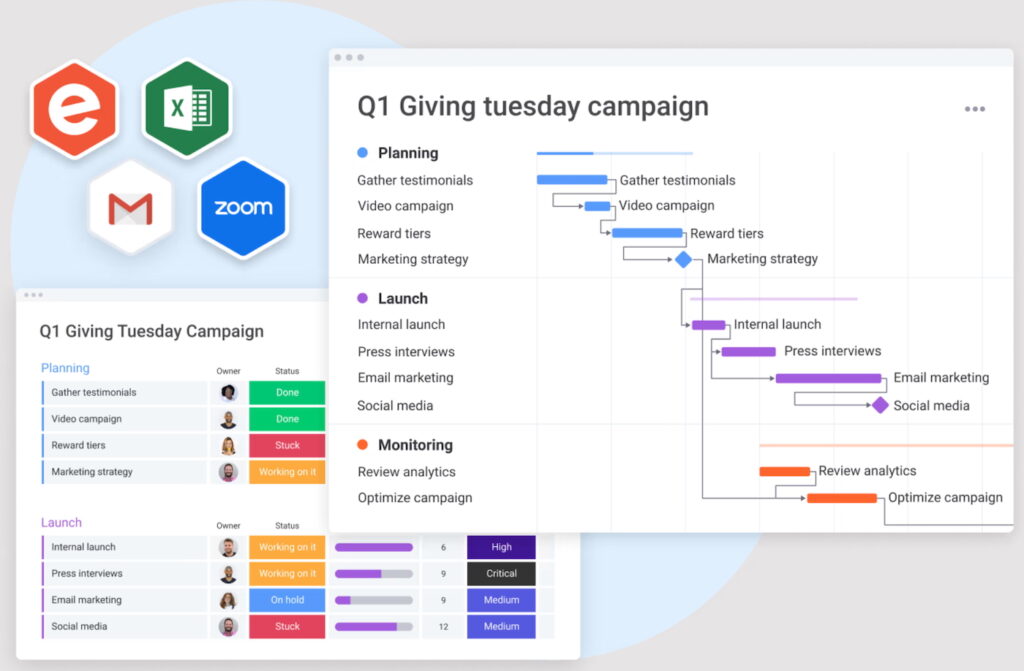
HubSpot CRM’s nonprofit add-on module: HubSpot offers a nonprofit add-on module that provides discounted pricing and tailored features for nonprofits, including donor management, marketing automation, and engagement tracking to support their mission-driven goals.
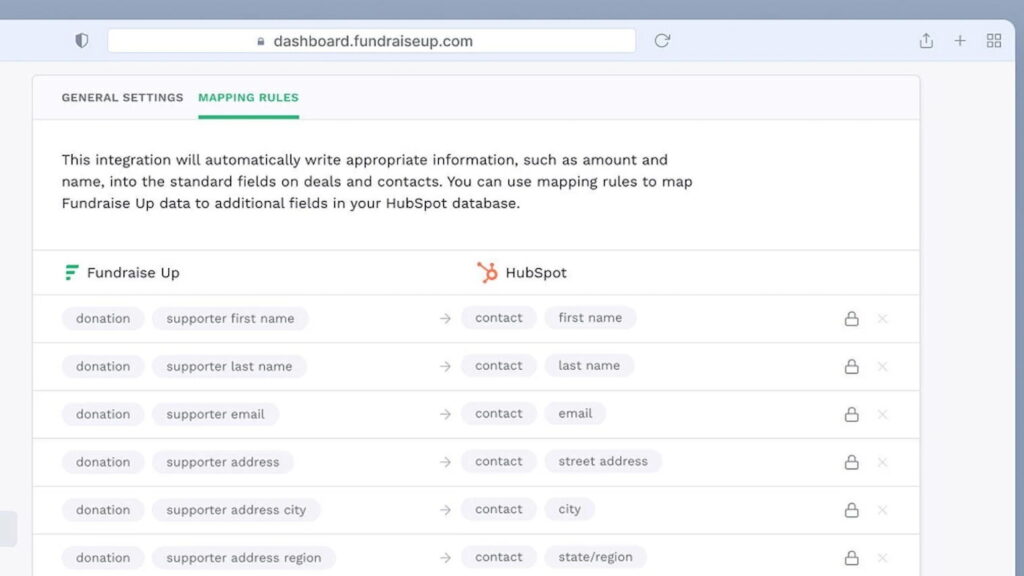
DonorPerfect: Specifically designed for fundraising, DonorPerfect streamlines donor management, tracks donations, and generates reports for analysis. It offers integration with email marketing tools and online fundraising platforms.
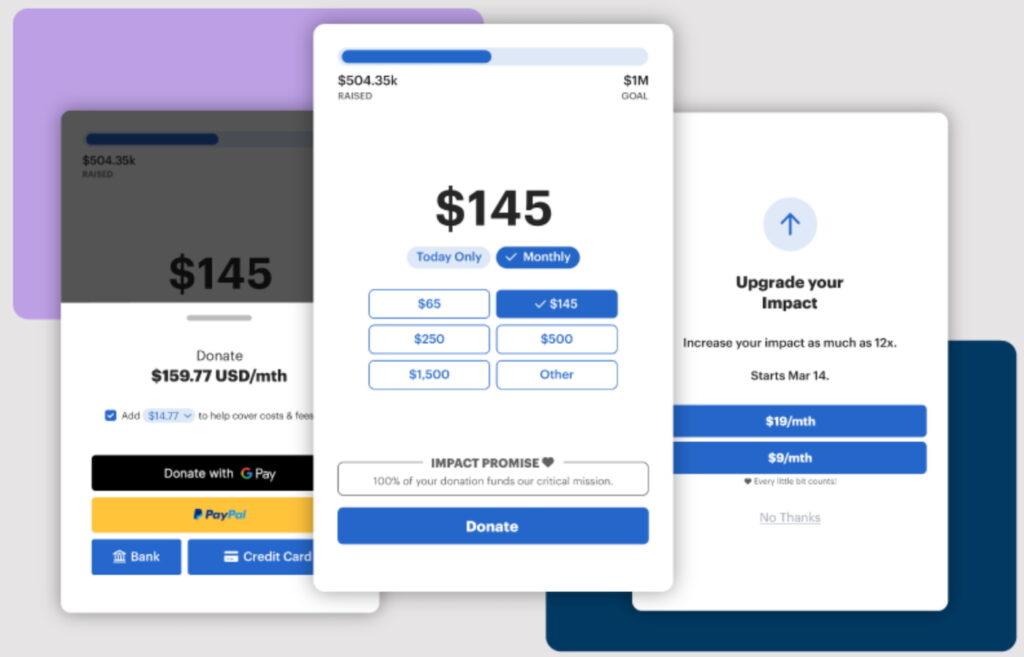
Kindful: Offers donor management, online fundraising, and reporting tools tailored for smaller nonprofits. It integrates with various platforms and provides intuitive dashboards for tracking fundraising progress.
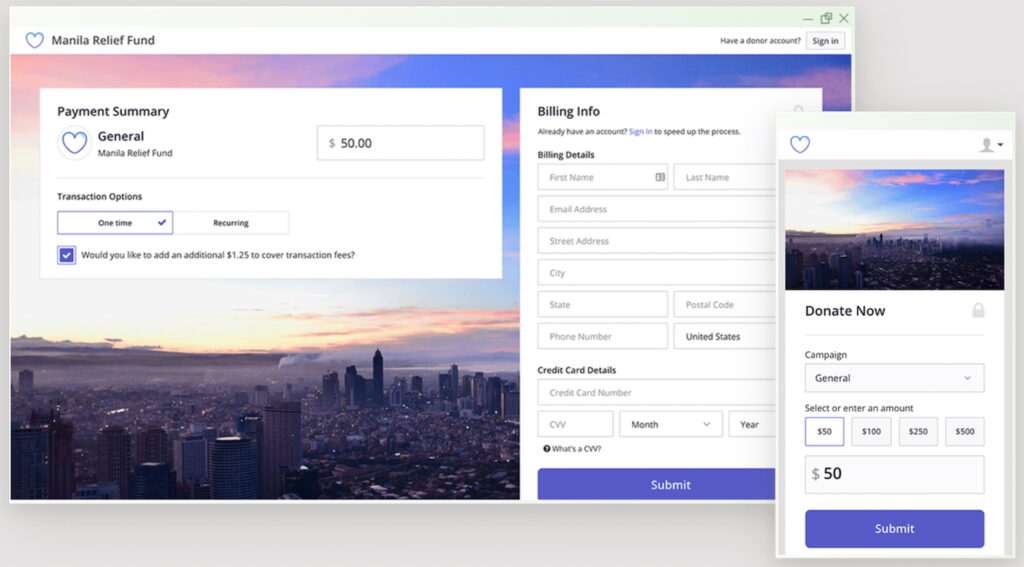
When selecting a CRM tool, consider scalability, ease of use, integration capabilities, and pricing to ensure it aligns with your nonprofit’s needs and budget. Additionally, inquire about nonprofit discounts or unique pricing options that CRM providers offer.
Also read: Nonprofit Software Guide
Legal and compliance factors influencing nonprofit organizational structure
When structuring a nonprofit organization, legal and compliance factors are crucial in ensuring transparency, accountability, and adherence to regulations.
1. Governance requirements
Most jurisdictions require a board of directors to oversee the nonprofit’s mission and finances. Nonprofits must follow bylaws that outline governance policies, board elections, and decision-making processes.
2. Tax-exempt status & IRS compliance
To qualify for 501(c)(3) tax-exempt status (in the U.S.), nonprofits must meet IRS regulations regarding mission, operations, and financial reporting. Nonprofits cannot distribute profits to individuals (private inurement rules). They must file an IRS Form 990 annually to disclose financial activities.
3. Employment laws and labor regulations
Nonprofits must comply with labor laws, including minimum wage, overtime pay, and employee benefits. Volunteer classification must be clear to avoid legal issues related to unpaid labor.
4. State & local registration requirements
Nonprofits must register with state agencies to conduct fundraising and business activities. Some states require annual reporting and nonprofit financial statements.
5. Charitable solicitation and fundraising regulations
Many states require nonprofits to obtain fundraising licenses before soliciting donations. Complying with anti-fraud laws and being transparent in donor communications are also essential.
6. Conflict of interest policies
A conflict of interest policy is required to prevent board members and staff from making decisions that benefit them personally. The IRS recommends that nonprofits adopt and enforce conflict disclosure procedures.
7. Data protection and privacy laws
Nonprofits handling donor or member data must comply with privacy laws such as GDPR (EU), CCPA (California), and HIPAA (for health-related data). Secure handling of donor payment information must align with Payment Card Industry (PCI) compliance standards.
Also read: 7 Best Nonprofit Payment Processing Tools
8. Liability & risk management
Nonprofits should have liability insurance for board members, employees, and volunteers. Policies for financial audits, whistleblower protection, and ethical conduct must be in place.




